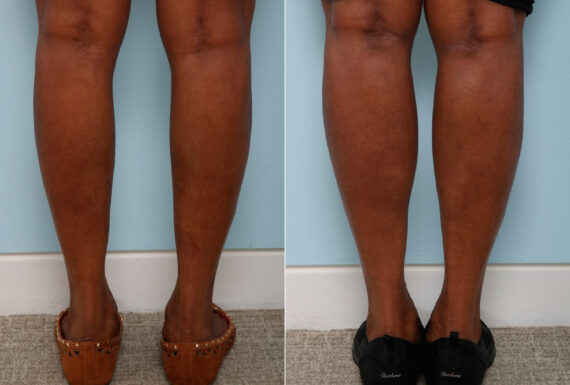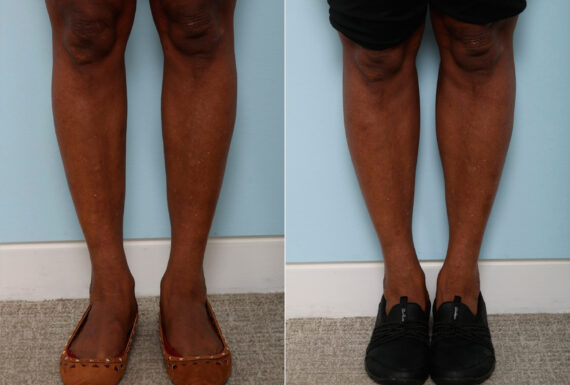Calf implants are a cosmetic surgery option for people who want to improve the shape and size of their lower legs. This might be for aesthetic reasons or to correct imbalances in physical appearance. It’s important to think about the costs involved, as well as what you might gain from it and the possible risks.
In our discussion, we will consider insights from Dr. Paul Vitenas, to help you understand the price of calf implants, what you can expect from the procedure, the associated risks, and other choices you might have. We aim to provide clear information to help you decide if calf implants are a worthwhile investment.

Are Calf Implants Worth it?
- Calf implants can enhance leg shape and size, leading to improved body symmetry and aesthetic appeal.
- The cost of calf implant surgery might be significant, depending on the complexity and the surgeon’s expertise.
- Evaluating the satisfaction rates of calf implant procedures helps determine if the investment aligns with desired outcomes.
- Recovery from calf implant surgery requires downtime, and patients should consider the time investment as well.
- There are non-surgical alternatives to calf implants that can be explored, such as exercise or fillers, which may offer a more budget-friendly option.
Evaluating the Value of Calf Implant Investment
Calf implants provide more than a purely aesthetic enhancement. Individuals dealing with underdeveloped calf muscles or asymmetrical calves often find the change has a deep psychological impact. Gaining well-proportioned calves aligns with personal body goals, and can markedly improve one’s self-esteem.
People who have been self-conscious about the calf shape find that calf implants can significantly raise their confidence. This newfound confidence can positively affect many areas of life, including personal and professional relationships. The benefits of calf implants include:
- Achieving symmetry between calves, contributing to a balanced body image.
- Increased confidence in situations where legs are visible.
- A positive shift in self-perception, leading to better mental health.
Such an improvement in confidence can affect how individuals present themselves and engage with others, offering both aesthetic benefits and a psychological boost to confidence.
Understanding Calf Implant Costs
Calf implant surgery often involves various expenses. The cost of calf implants is influenced by factors such as surgeon experience, procedural complexity, and geographic location. The calf augmentation cost typically includes the surgeon’s fee, anesthesia, and the use of the surgical facility.
Pre-surgery consultations and post-surgery care, which might include medications, special garments, and physiotherapy sessions, should also be budgeted for. Hidden costs can arise from complications, time away from work, follow-up visits, transportation, and potential revisions.
Our practice provides payment plans, and third-party services may offer financing dedicated to healthcare costs. A detailed conversation with your surgeon about the calf implant procedure can help clarify these financial considerations.
Key Cost Components:
- Surgeon’s fee
- Anesthesia
- Facility use
- Pre- and post-operative care
- Medications and garments
- Potential loss of income
- Travel for follow-up visits
- Revisions if needed
Discuss your payment and financing options during your first consultation session.
Outcomes and Advantages of Calf Implant Investment
Calf implants contribute to an increase in calf muscle mass, offering an improved appearance and well-defined gastrocnemius muscle. Those who undergo calf augmentation surgery can expect to see a more symmetrical and defined body silhouette.
Patients tend to experience a notable rise in self-esteem due to the improved definition of their calves. This surgical procedure is designed and performed carefully to ensure a natural look.
With a successful calf augmentation surgery, long-term results usually include maintained calf muscle mass and shape. Calf augmentation patients often express positive feedback, with many noting improvements in the fit of their clothes and a boost in self-assurance during activities that reveal the legs. The positive effects of calf augmentation support a healthier body image:
- Increased calf muscle mass
- A proportionate body silhouette
- Maintenance of long-term results
- High satisfaction rates among patients
The procedure has been seen as a worthwhile option for those seeking to improve their lower body aesthetic, as patients frequently attest to the lasting benefits of calf augmentation.
Recognizing and Addressing Common Complications
Calf augmentation procedures come with certain risks. It’s possible for patients to face issues such as infection, asymmetry, and implant displacement. To minimize these common complications, it is essential to choose a skilled surgeon proficient in submuscular placement. Proper adherence to post-surgical care is vital. Important care steps include:
- Strictly following wound care instructions
- Avoiding activities that may hinder the healing process
- Watching for signs of infection and seeking timely medical attention
Choosing a board-certified plastic surgeon with expertise in calf augmentation can greatly reduce the potential for these problems.
Selecting the Right Surgeon
The success of a calf augmentation procedure heavily relies on the surgeon’s skill. A board-certified plastic surgeon serves as an indicator of quality training and expertise. Look for a surgeon with a specific focus on calf implants, as this experience ensures they can customize the procedure to each patient’s body for optimal results.
Understanding Recovery Time and Care
Calf augmentation recovery typically spans weeks. During recovery, it’s crucial to implement the post-surgical care plan given by your surgeon to aid healing, which includes:
- Keeping your legs elevated
- Avoiding putting weight on your calves
- Slowly starting to walk again to help with blood flow
A board-certified plastic surgeon is not only technically adept but also integral in guiding you through calf augmentation recovery and post-surgical care, equipping you with the right information for a successful outcome.
Alternatives to Calf Implants and Their Value Comparison
Interested individuals may consider alternatives to calf implants for calf enhancement. Calf exercises are beneficial for building muscle mass and definition through regular workouts. Fat grafting is another less invasive method that provides a natural result by transferring the patient’s own fat to the calves.
Assessing the cost of calf augmentation includes looking at permanent solutions versus temporary options. Calf implants are more expensive upfront but offer a permanent result with few ongoing costs, though they involve the risks associated with cosmetic body surgeries. On the other hand, body contouring procedures like fat grafting can be less expensive initially but might need additional treatments over time. The cost-benefit analysis also takes into account non-surgical methods like calf exercises, which have minimal costs but require continuous effort for upkeep. Here’s a brief comparison:
| Aspect | Calf Implants | Calf Exercises | Fat Grafting |
|---|---|---|---|
| Initial Cost | High (includes surgeon’s fees, anesthesia, etc.) | Low (Gym fees or equipment) | Moderate (includes surgeon’s fees, anesthesia, etc.) |
| Maintenance Cost | Low (occasional check-ups) | Continuous (gym membership, time) | Possible additional treatments for touch-ups |
| Longevity | Permanent (may need revision with aging/weight changes) | Variable (depends on consistency and effectiveness of exercise regimen) | Semi-permanent (may be absorbed by the body over time, requiring additional treatments) |
| Effectiveness | Immediate enhancement of calf contour and size | Gradual improvement in muscle tone and size | Natural-looking enhancement, though less dramatic than implants |
| Post-Procedure Care | Avoid strenuous activities, wear compression garments, and follow care instructions | Regular exercise, balanced diet, adequate rest | Avoid pressure on treated areas, follow post-operative care instructions |
| Expected Outcome | Improved calf size and shape, enhanced body proportion, and confidence in appearance | Improved muscle tone and size, enhanced physical fitness | Enhanced calf contour with a more natural feel compared to implants |
Overall, the cost-benefit analysis for calf augmentation should consider the economic aspect, the desired outcome, and the dedication to either maintenance treatments or ongoing calf exercises.
Deciding on Calf Implant Investment
Before choosing to undergo calf implant surgery, it’s crucial to gather as much information as possible. During your calf augmentation consultation, consider asking your surgeon the following:
- What are my expectations for recovery and results from calf implant surgery?
- Could you show me before-and-after pictures of others who have had the surgery?
- What risks and complications might I face?
- How long will it take to recover?
A candid conversation with your plastic surgeon can help you understand the process and set realistic post-surgery expectations.
Ideal candidates for calf augmentation often share certain characteristics. You might be a suitable candidate for calf implant if you:
- Are looking to improve calf size and shape
- Have good health without conditions that could affect healing
- Do not smoke
Booking a calf implant augmentation consultation offers the opportunity to discuss your objectives and medical history. Your surgeon will examine your lower leg structure and discuss the desired results to determine if calf augmentation is right for you.
Evaluating the Value of Investing in Calf Implants
Calf augmentation surgery offers a range of benefits. The procedure provides a contoured and muscular appearance for those who feel their calves lack volume or shape. The calf implant process boosts physical appeal and may enhance self-confidence and body image.
When considering calf implants, it’s important to evaluate:
- How the results align with your body aesthetics and aesthetic goals.
- The long-term advantages of calf implants considering cost and recovery.
- The influence on your daily lifestyle.
Each individual’s decision will depend on these personal considerations. The calf implant process can be a valuable choice for those seeking to meet specific body enhancement objectives.
If you’re considering calf implants and want advice tailored to your needs, schedule a consultation with Dr. Paul Vitenas. With decades of experience and a commitment to achieving balanced, aesthetic outcomes, Dr. Vitenas has helped countless patients reach their body image goals. His expertise as a top, board-certified plastic surgeon in Houston means you can trust the care and advice you’ll receive at Vitenas Cosmetic Surgery.
Understanding the value of calf implants requires expert insight, especially when weighing costs against expected outcomes. Contact our Houston office to set up a time to discuss your options with Dr. Vitenas and his experienced team. We’ll work with you to create a personalized treatment plan, ensuring your procedure aligns with your aesthetic aspirations.


